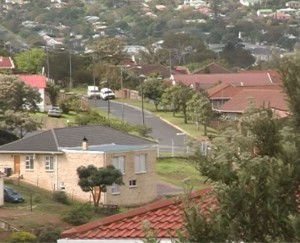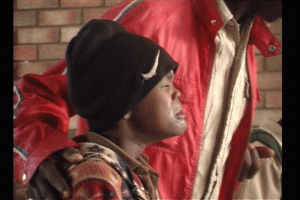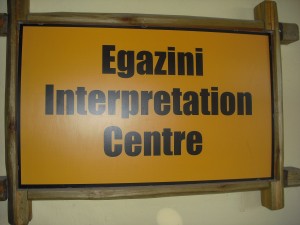A four minute documentary on Mother Zelma and the Sistersof St. Peter’s Rectory in Grahamstown and how their lives and desire to help the needy has been adversely affected by crime
Archive for the ‘Featured’ Category
Nuns pray for stronger communities
Picket Fence Prisons
By Tamzyn Degoumois, Roza Carvalho and Vuyo Tshekela
Our community meeting was held on Sunday 18 October at the NG Kerk Hall, in Hillsview, Grahamstown. Through the various media we had created about crime in the Hillsview, Sunnyside and Fort England area we aimed to generate discussion around possible community solutions.
Some of the main points of debate were impersonal and isolated nature of the community and how community engagement and building on a daily basis might be desirable, but unrealistic. For example, while some community members mentioned that they would like to help the people who come to their doors, they feel unsafe doing so. However, perhaps the most interesting moment in the meeting was when a resident spoke about the issue of men, their frustration at unemployment and lack of skills training, and how this is a social cause of crime in the community. This spoke to a general feeling that men have been emasculated, often feeding into issues like domestic violence and other crimes. The possible solution proposed was a skills training programme and a possible community fund to pay people within the area for odd jobs.
The following clip is an excerpt from the resident’s response.
Mapping the CBD
Public Journalism in Grahamstown.
We were assigned to the areas of the CBD and Oatlands. As Rhodes students, our group was already very familiar with these areas. Our first move was to create a civic map of the entire area; this entailed speaking to businesses as well as residents and the transient community on the streets about the area’s crime rate, or any problems; social or political that the community feel need to be addressed. We found that the biggest issue businesses and residents experienced were petty crime, break-ins and begging. Most businesses and residents seem sure that the perpetrators are street children and beggars. So we decided that for our documentaries we would focus people who rely on the streets of the CBD to make some money. We came across Given (Informal Lily seller) and Robocop (Informal car guard/ Washer). After speaking to both these characters we gained more insight into their lives and how they themselves have been affected by crime. Both themselves former criminals, they now are part of the informal business life of the Grahamstown CBD.
The main point about civic journalism is that the journalists are citizens first, and media practitioners second. We spoke with Given and Robocop and discussed our own experiences of crime. We engaged on a level where we shared similar stories and spoke about ways that we could all work together to combat the crime problem in the CBD.
Youth Crime in Grahamstown Townships
We have gathered together these three clips to explain our experience as journalists in the local community. We gathered the first clip on our ‘mapping the area’ exercise which stipulated that we needed to pin-point the main problems with regards to crime in the area. We found out from numerous sources that most of the crime has been committed by the youth. The man we captured on film was a victim of crime in the area and agreed with the general consensus that it was the youth in the area causing the crime.
We hoped to attempt this project by constantly referring back to the foundations of public journalism. In all our pieces of work we used the afflicted parties to represent the issue in the area. We sought to use our journalism as a means of assisting the community. By this we produces a self defence project which is to carry on in the community to empower members of sun city and outlying areas against crime and violence.
The next clip is taken three weeks later and is of two teenagers who wanted to speak on camera. Our presence in the community was known by then and the boys knew why we were there. They sarcastically expressed their views of how they wanted to stop committing crime and how they were ready to change. It was all said in jest and the one guy even tried to kiss Mahreen.
We felt as if our project wasn’t reaching the community but then our hopes were uplifted by Janet, one of the community leaders at our community meeting. She said that she was grateful our project had come into her community and alerted them to the problems and possible solutions available to the members of the community. We thought we’d achieved some sort of success by joining with the community to provide a product with relevant important information for the community.
See our Generation Join-Up blog for more info.
“Living in Fear”
 Public Journalism: Public journalism is a form of media research which differs from the conventional way of journalism. Whereas conventional journalism has traditional roots and respects the notion of objectivity, public or civic journalism encourages change, citizen participation and journalistic activism. Public journalism seeks to address people as citizens, citizens who can act upon a certain issue, in this case crime. Our public journalism campaign focused on the areas of Somerset Heights, Oatlands North and Currie Park. These areas are home to Grahamstown’s middle to upper class society.
Public Journalism: Public journalism is a form of media research which differs from the conventional way of journalism. Whereas conventional journalism has traditional roots and respects the notion of objectivity, public or civic journalism encourages change, citizen participation and journalistic activism. Public journalism seeks to address people as citizens, citizens who can act upon a certain issue, in this case crime. Our public journalism campaign focused on the areas of Somerset Heights, Oatlands North and Currie Park. These areas are home to Grahamstown’s middle to upper class society.
Private security trumps state security in these areas. Being part of the middle/upper class, residents in these areas are able to invest in private security to protect their property. There appears to be a relationship of trust with private security companies, such as Hitec in particular. However this same relationship is missing when it comes to the police. The residents view the police as being ‘inefficient and incompetent’ and this contributes to the negative perception and strenuous relationship the residents have with them. As public journalists we need to identify the problems citizens face, and together with the citizens attempt to facilitate change and work towards a resolution. This clip was the first step towards understanding how the residents feel about the police. This clip was also shown to the police so that they gain an understanding of the problems faced by the residents in terms of policing. A resident expresses his views on Hitec and the Police:
Resident Apathy:
The issue of apathy was also a major topic of discussion not only between the residents and the police but among the residents themselves. The police feel that the residents are apathetic when asked to assist in measures to tackle crime. By highlighting the problem of apathy among residents in the focus group, a public journalism approach aims to actively seek the engagement of citizens in the process of public problem solving. So apathy on the part of the residents is in direct contrast to the ideals of participant based civic journalism. Highlighting a particular issue and making the public aware of its existence and meaning is the first step towards tackling it and bringing about change. Apathy through the eyes of a resident:
Answering the Communities issues:
The community meeting provided the residents with the chance to raise their concerns towards the police. The meeting stimulated discussion between the residents and the police, and issues that were previously unknown to the police were raised and responded to adequately. Public journalism is a response to 2 widening gaps- in our context the gap between the residents and the police. By allowing communication and discussion forums such as these, we as public journalists are initiating the first steps towards building bridges and repairing the relationship between these two entities. As media professionals we can help in the process of resolution between the police and the residents. A resident vents his frustration towards the process of reporting crime:
Art for Development
ART FOR DEVELOPMENT
This blog takes a look at some of the initiatives in Grahamstown which aim to use art to develop the youth. Such projects use art, dance, drama, poetry and play as a means to keep youngsters out of trouble.
Egazini Arts and Crafts Outreach Project
This blog takes a look at some of the initiatives in Grahamstown which aim to use art to develop the youth. Such projects use art, dance, drama, poetry and play as a means to keep youngsters out of trouble.
We visited the Egazini Arts and Crafts Outreach Project, run by Bongani Diko. This group uses drama to stimulate some of the youth in the townships. This group has been so successful that they are performing at this years National Arts Festival. Their show is entitled ” My Xhosa”. Simply click on the link below to find out more about their performance…

We went to watch one of their rehearsals, and spoke to Diko about the impact that this initiative has on these youngsters’ lives. For this exclusive preview watch the short video clip below…
Hope you enjoyed that?
Let us know if you are planning on attending the show by commenting below…
We also compiled a slideshow of some of the artwork that is created at Egazini. There are many artists who work on commission to produce linocuts, paintings, etchings and wood cuts.
To watch and learn more about Egazini’s projects click on the link below…
Janet Buckland: Amaphiko Township Dance Project
We also spoke to Janet Buckland who is this years Shoprite/Checkers Woman of the Year. We spoke to her about the Amaphiko Dance Project she runs.
This project uses dance to help the under-privileged youth of Grahamstown become excited about their talents.
To hear what Buckland had to say about this project listen to this audio clip…
Keep Kids Off the Streets
We also uncovered a new inititaive called Keep Kids Off the Streets (KKOTS). This intitive is run by local community members who are trying to keep the youth out of mischief. This project runs every Saturday at the Recreation Hall in Tantyi township. It is the collaborative project of the Centre for Social Development (CSD) and volunteers from Rhodes University and around Grahamstown.
Carol Johnson, from the CSD, spoke to us about this new initiative. Listen to the audio clip that we compiled below…
We interviewed a community member who is actively involved in the KKOTS program. Watch this short video clip to find out more…

